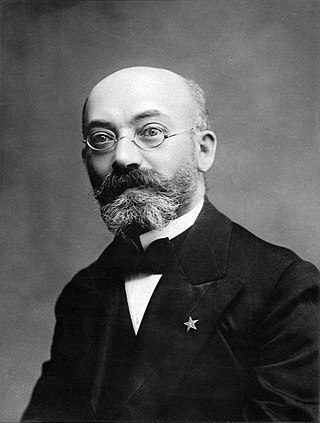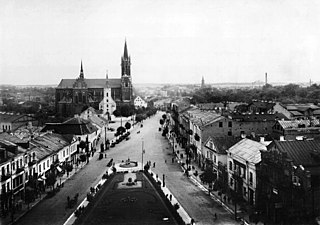
L. L. Zamenhof was the creator of Esperanto, the most widely used constructed international auxiliary language.

Białystok is the largest city in northeastern Poland and the capital of the Podlaskie Voivodeship. It is the tenth-largest city in Poland, second in terms of population density, and thirteenth in area.

Branicki Palace is a historical edifice in Białystok, Poland. It was developed on the site of an earlier building in the first half of the 18th century by Jan Klemens Branicki, a wealthy Polish–Lithuanian Commonwealth hetman, into a residence suitable for a man whose ambition was to become king of Poland. The palace complex with gardens, pavilions, sculptures, outbuildings and other structures and the city with churches, city hall and monastery, all built almost at the same time according to French models was the reason why the city was known in the 18th century as Versailles de la Pologne and subsequently Versailles de la Podlachie.

Kolnopronounced[ˈkɔlnɔ] is a town in northeastern Poland, located in the Podlaskie Voivodeship, about 150 km northeast of Warsaw. It is the seat of Kolno County, and the seat of the smaller administrative district (gmina) called Gmina Kolno, but it is not part of this district, as the town has gmina status in its own right. Kolno has 10,730 inhabitants (2007).

The Warsaw Jewish Cemetery is one of the largest Jewish cemeteries in Europe and in the world. Located on Warsaw's Okopowa Street and abutting the Christian Powązki Cemetery, the Jewish necropolis was established in 1806 and occupies 33 hectares of land. The cemetery contains over 250,000 marked graves, as well as mass graves of victims of the Warsaw Ghetto. Although the cemetery was closed down during World War II, after the war it was reopened and a small portion of it remains active, serving Warsaw's existing Jewish population.

Szymon Datner was a Polish historian, Holocaust survivor and underground operative from Białystok, who was born in Kraków and died in Warsaw. He is best known for his studies of the Nazi war crimes and events of The Holocaust in the Białystok region. His 1946 Walka i zagłada białostockiego ghetta was one of the first studies of the Białystok Ghetto.

Veisiejai is a town in the Lazdijai district municipality, Lithuania. It is located 18 km (11 mi) south-east of Lazdijai. The Esperanto language was created in Veisiejai where L. L. Zamenhof started his practice as an ophthalmologist in 1885. There is a church dedicated to St. George, an old estate with a park, high school, kindergarten "Ąžuoliukas", a post office, a museum and monuments dedicated to the composer J. Neimontas and L. L. Zamenhof.

Louis-Christophe Zaleski-Zamenhof was a Polish-born French civil and marine engineer, specializing in the design of structural steel and concrete construction. He was a grandson of the Polish Jewish L. L. Zamenhof, the inventor of the international auxiliary language Esperanto. From the 1960s until his death, Zaleski-Zamenhof lived in France.

The city of Białystok has existed for over five centuries, during which time the fate of the city has passed between various political and economic forces.
In the early 1900s, Białystok was reputed to have the largest concentration of Jews of all the cities in the world. In 1931, 40,000 Jews lived in the city, nearly half the city's inhabitants. The city is the seat of the Roman Catholic Archdiocese of Białystok. Establishment of the Diocese and the Archdiocese and the cities of Bialystok ended the period of the temporary church administration in the Bialystok region owned lands over the centuries to the Archdiocese of Vilnius, which after World War II remained in the Polish borders. The city is also the seat of the Bialystok-Gdansk Diocese of the Autocephalous Polish Orthodox Church. Bialystok is the largest concentration of Orthodox believers in Poland.

Białystok is one of the largest cultural centers in the Podlaskie Voivodeship. The attractions include performing arts groups, art museums, historical museums, walking tours of architectural / cultural aspects and a wide variety of parks and green spaces. Białystok in 2010 was on the short-list, but ultimately lost the competition, to become a finalist for European Capital of Culture in 2016.

Maurycy Trębacz was one of the most popular Jewish painters in Poland in the late 19th and early 20th century. Many of his paintings were lost in the Holocaust, but a representative selection of his artwork survived. Trębacz died of starvation in the Litzmannstadt Ghetto during the Nazi German occupation of Poland.

Abraham Adolf Behrman was a painter of interwar Poland best known for his outdoor paintings of Jewish shtetl life as well as landscapes and group portraits. He spent most of his life in Łódź and was murdered during the liquidation of the Białystok Ghetto in the Holocaust.
The following is a timeline of the history of the city of Białystok, Poland.

The Jewish Hospital in Warsaw, The Jewish Hospital in Czyste - a Jewish medical facility operating from 1902 to 1943 in Warsaw. For many years considered to be one of the best and most modern hospitals in Poland.

The Cytron Synagogue, also known as the Beit Midrash Cytron, is a former Orthodox Jewish congregation and synagogue, located at 24a Ludwika Waryńskiego Street in Białystok, in Podlaskie Voivodeship, Poland. Completed in 1936 in the Modernist style, the construction was funded by Shmuel Cytron, it served as a house of prayer until World War II; subsequently used for profane purposes, and as the Sleńdzińscy Gallery, an art gallery.

Lipowa Street is a representative street at the center of Białystok, Poland, running from the Kościuszko Square to Romana Dmowskiego Niepodległości Square. The street is made up of low buildings mostly of 2-3 floors with various shops, offices and restaurants located at the ground floor.
History of the Jewish community of Bialystok, the capital of Podlaskie Voivodeship in northeastern Poland, dates back to the mid-17th century. The local Jewish community grew rapidly, and from the beginning of the 19th century made up more than half of the entire population of Bialystok: until the First World War, Jews made up 66%-75% of the city's population, but between the two world wars the proportion of Jews dropped to 50%-60% of the residents.

Zinaida Khvolesova Jewish Girls' High School – school for girls founded in 1911 in Białystok.


















